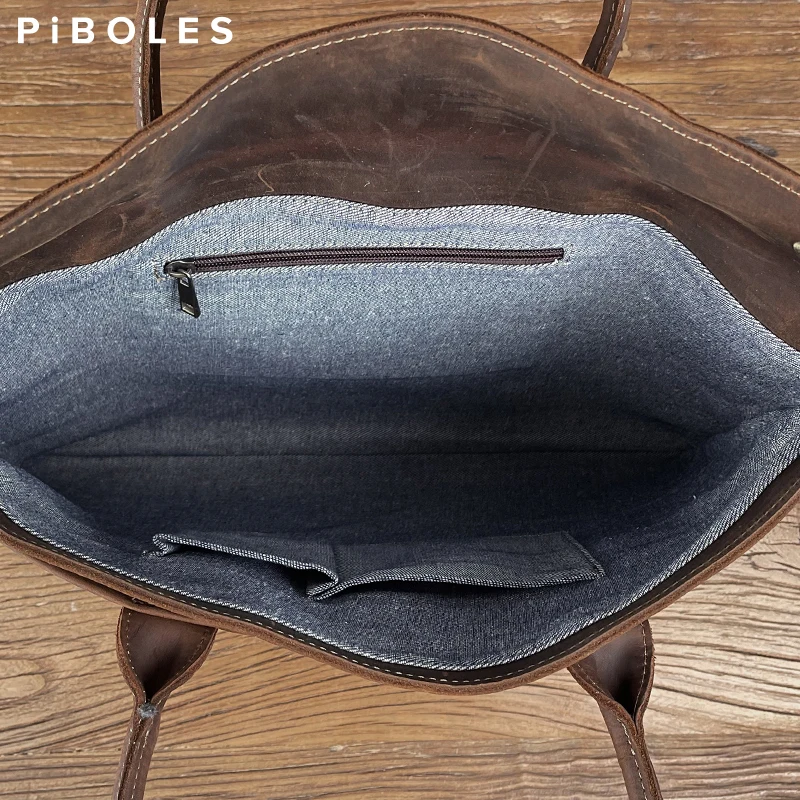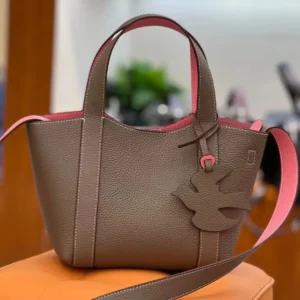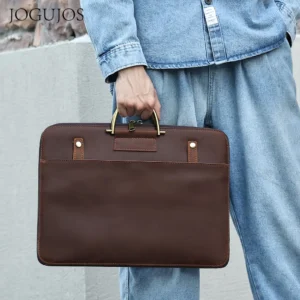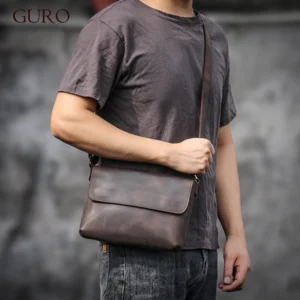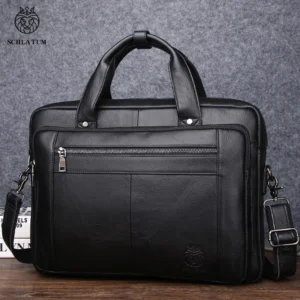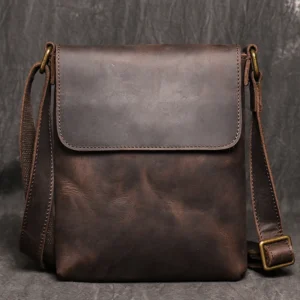Understanding Your Daily Carry Needs: The Foundation of Your Decision
The right business bag isn’t just an accessory—it’s an essential professional tool that accompanies you through meetings, presentations, and daily work life. Whether you’re heading to a boardroom or a coffee shop workspace, your bag serves as both a functional necessity and a statement of your professional identity.
Before diving into the slim versus large debate, take a moment to assess what you actually carry each day. This inventory forms the foundation of your entire decision-making process. The items you transport daily directly determine the minimum capacity requirements for your professional companion.
Consider creating a comprehensive “daily carry inventory” by categorizing your items:
- Essential Electronics: Laptop (note exact dimensions), tablet, smartphone, chargers, power bank, adapters
- Business Documents: Folders, notebooks, planners, important papers, business cards
- Personal Items: Wallet, keys, glasses, medications, grooming products
- Occasional Extras: Umbrella, water bottle, lunch container, gym clothes
The specific dimensions matter significantly—a 13-inch laptop occupies considerably less space than a 16-inch model, while A4 folders require different accommodation than a small notebook. Understanding the foundation for choosing the right business bag helps ensure you don’t end up with something that looks great but fails to meet your practical needs.
Many professionals find that guidance on assessing your carrying needs reveals surprising patterns in their daily requirements. For example, some discover they’re carrying redundant items or could consolidate electronics with multifunctional devices. This assessment often points clearly toward either a slim professional bag or something more substantial.
Your Professional Context: Commute, Environment, and Image
Commute Considerations
Your daily journey significantly influences which bag will serve you best. Crowded public transportation with limited space calls for a different solution than driving with trunk storage. Standing-room-only subway commutes might make a slim, close-to-body profile more practical, while car commuters may appreciate additional capacity without concern for maneuverability.
Workplace Environment
Different professional settings create varied bag requirements. Traditional law firms or banking environments typically favor sleek, understated designs that complement formal attire. Creative agencies might welcome more expressive or casual designs. Hybrid remote workers need versatility to transition between home office, coffee shops, and occasional in-person meetings.
Professional Image
Your bag serves as an extension of your professional image and personal brand. Consider how it complements your typical work attire and what it communicates about your organizational style and attention to detail. The right choice subtly enhances your credibility while the wrong one can create disconnect in your professional presentation.
Travel Frequency
If your position involves frequent travel, your needs expand considerably. Day trips demand space for additional materials and perhaps snacks, while overnight business travel might require room for a change of clothes or toiletries. Frequent travelers often benefit from insights for commuters who face similar challenges in maintaining efficiency while on the move.
Slim Business Bags: The Essence of Streamlined Professionalism
A slim business bag typically measures between 3-5 inches (7.5-12.7 cm) in depth, accommodating laptops up to 15 inches (38 cm) and 1-2 thin document folders. These bags prioritize a sleek silhouette and professional appearance over maximum storage capacity.
Advantages of Slim Business Bags
- Professional Aesthetics: Creates a polished, streamlined appearance that complements formal business attire
- Mobility and Maneuverability: Easier navigation through crowded spaces, public transportation, and busy offices
- Posture-Friendly: Lighter weight reduces strain on shoulders and back during extended carrying
- Forces Organization: Limited space encourages thoughtful curation of essential items only
- Fits Seamlessly: Tucks neatly under airplane seats or beside you in meetings without creating obstacles
Limitations to Consider
- Capacity Constraints: May require tough decisions about what to carry and what to leave behind
- Limited Expansion: Cannot easily accommodate unexpected items or last-minute additions
- Less Division: Fewer organizational compartments than larger counterparts
- Tight Fit: Items may require precise arrangement to close properly when fully loaded
The ideal user for a slim bag is the minimalist professional who travels light, maintains a paperless or low-paper workflow, and values mobility throughout their day. This profile includes consultants moving between client sites, executives attending sequential meetings, and professionals in metropolitan areas who value efficiency in movement.
Common slim bag styles include attaché cases, slim briefcases, document portfolios, and streamlined messenger designs. Each offers distinctive advantages—attaché cases provide structure for important documents, while slim briefcases balance professional appearance with modest functionality. The options for men’s slim briefcases demonstrate the variety available within this streamlined category.
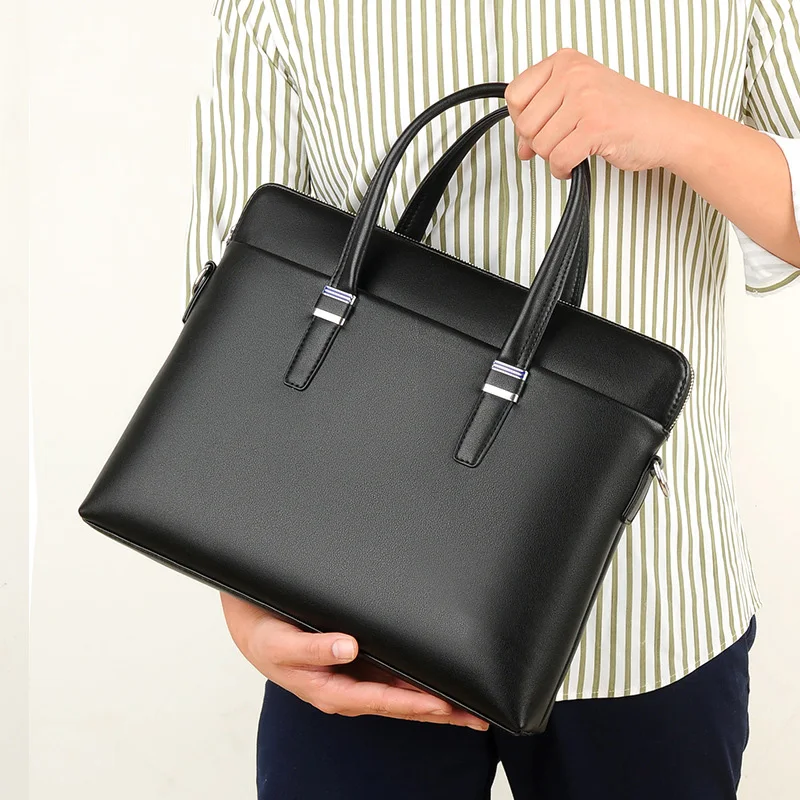
Large Business Bags: Maximum Versatility for the Well-Equipped Professional
Large business bags typically measure between 5-8 inches (12.7-20.3 cm) in depth and offer significantly more volume than their slim counterparts. These bags accommodate laptops of all sizes, multiple document folders, tech accessories, and personal items with room to spare.
Advantages of Large Business Bags
- Abundant Storage: Room for all essentials plus contingency items and unexpected additions
- Superior Organization: Multiple dedicated compartments for organized storage and easy access
- Versatility: Transitions easily between daily commute, business travel, and weekend use
- Self-Sufficiency: Carry everything needed for a productive day without relying on external storage
- Consolidated Carrying: Potential to replace multiple bags with a single solution
Limitations to Consider
- Bulk and Weight: Can become cumbersome when fully loaded, impacting mobility
- Space Management: May occupy significant space in tight meeting rooms or dining situations
- Overpacking Tendency: Extra space can lead to carrying unnecessary items that add weight
- Less Formal Appearance: May appear less sleek with some formal business attire
The ideal user for a large business bag is the fully-equipped professional who requires immediate access to various materials throughout their day. This includes professionals who travel between office and client sites, those who carry presentation materials or specialized equipment, and individuals who prefer consolidating work, gym, and personal items into a single carrying solution.
Common large bag styles include expandable briefcases, business backpacks, large messenger bags, and professional totes. Expandable briefcases maintain a classic profile with added capacity, while business backpacks distribute weight effectively for comfortable carrying. The options for large capacity work bags show the range of solutions available for professionals who need substantive storage.
For professionals still weighing their options, a detailed comparison of large vs slim options can provide valuable insights into specific differences between these two approaches.
Material and Durability: Balancing Aesthetics, Longevity, and Function
Premium Leather
Full-grain leather represents the highest quality option, offering exceptional durability with a patina that improves with age. This material presents a refined professional appearance but requires regular maintenance to maintain its luster and protect against moisture. Though initially more expensive, quality leather typically provides superior cost-per-use value through its longevity.
Performance Textiles
Ballistic nylon, originally developed for military flak jackets, delivers outstanding durability and abrasion resistance while remaining lighter than leather. Premium canvas, especially when waxed, offers a distinctive look with good weather resistance but may require occasional reproofing. These materials often feature in bags that balance professional appearance with practical functionality.
Construction Quality Indicators
Regardless of material choice, certain construction elements separate professional-grade bags from their casual counterparts. Look for reinforced stitching at stress points, edge coating or binding on leather edges, quality hardware (zippers, clasps, buckles) from recognized manufacturers, and internal reinforcement in areas that carry weight.
Weather resistance varies significantly across materials and construction methods. Full-grain leather with proper treatment offers good water resistance but may require shelter during heavy downpours. Technical textiles typically provide superior protection against elements but may sacrifice some professional aesthetic appeal. Information on leather quality for business bags can help you understand the relationship between material selection and long-term performance.
Organization Systems: Accessing Your Tools Efficiently
Professional bags distinguish themselves from casual options through thoughtful interior organization that facilitates quick access to business essentials. The difference between fumbling for a business card and smoothly retrieving it can impact your professional presence significantly.
Organization in Slim Designs
Slim bags maximize limited space through clever compartmentalization. Look for designs featuring:
- Padded laptop sleeves positioned against the back panel
- Document dividers that maintain paper integrity
- Slim-profile pen holders and card organizers
- Strategically placed smartphone pockets for quick access
- Compression straps to secure contents in minimal space
Organization in Large Designs
Larger bags offer more extensive organization possibilities including:
- Multiple segregated compartments for different functions
- Expandable sections for variable capacity needs
- Dedicated power bank and cable management systems
- Insulated pockets for food or beverages
- Removable organizer pouches for customizable configuration
Exterior access features benefit both designs, with security-conscious quick-access pockets for frequently used items like transit cards or smartphones. Some innovative bags now include external USB ports connected to internal power bank compartments for charging on the move.
The most efficient organization systems recognize the workflow of modern professionals. Organization strategies for business documents can significantly enhance your productivity regardless of the bag size you choose.
Ergonomics and Comfort: The Impact of Daily Carrying
The physical experience of carrying your bag throughout the day dramatically influences your overall satisfaction, regardless of its aesthetic appeal or organizational brilliance.
Slim bags typically weigh 2-3 pounds (0.9-1.4 kg) when empty, while their larger counterparts often weigh 3-5 pounds (1.4-2.3 kg) before adding contents. When fully loaded, this difference becomes even more pronounced—a slim bag might total 5-7 pounds (2.3-3.2 kg) while a large one could reach 10-15 pounds (4.5-6.8 kg) or more.
Weight distribution significantly impacts carrying comfort. Bags with wider straps distribute pressure more effectively across your shoulder or body. Padded back panels prevent hard objects from pressing against your body. Adjustable straps allow customization to your body type and height.
Carrying systems vary in their ergonomic benefits:
- Traditional handles work well for short distances but concentrate weight in one hand
- Single shoulder straps distribute weight but may cause posture imbalance over time
- Cross-body messenger designs improve stability and weight distribution
- Backpack systems provide the most balanced weight distribution for heavier loads
Your commute length should directly influence your ergonomic priorities. A bag carried from car to office requires less ergonomic consideration than one accompanying you through a 45-minute walking commute. Messenger options with ergonomic designs offer solutions that balance professional appearance with carrying comfort.
Security and Protection: Safeguarding Your Professional Tools
Professional bags must protect valuable contents from both physical damage and theft—concerns that vary somewhat between slim and large designs.
Protection Systems
Slim bags typically offer adequate padding for electronics but with less buffer space around items. Large bags provide more comprehensive protection through:
- Impact-absorbing padding around vulnerable items
- Suspended laptop compartments that prevent contact with the ground when set down
- Water-resistant materials or covers that shield contents during unexpected weather
- Rigid frames or reinforcement panels that maintain shape and prevent crushing
Security Features
Modern professional bags increasingly incorporate security elements:
- RFID-blocking pockets for protecting sensitive credit cards and ID badges
- Lockable zippers or access points for high-security situations
- Hidden compartments for valuable items like passports or emergency cash
- Cut-resistant materials or reinforced straps to deter theft attempts
For professionals who frequently encounter inclement weather, understanding weatherproofing for business bags becomes essential for protecting valuable electronics and important documents.
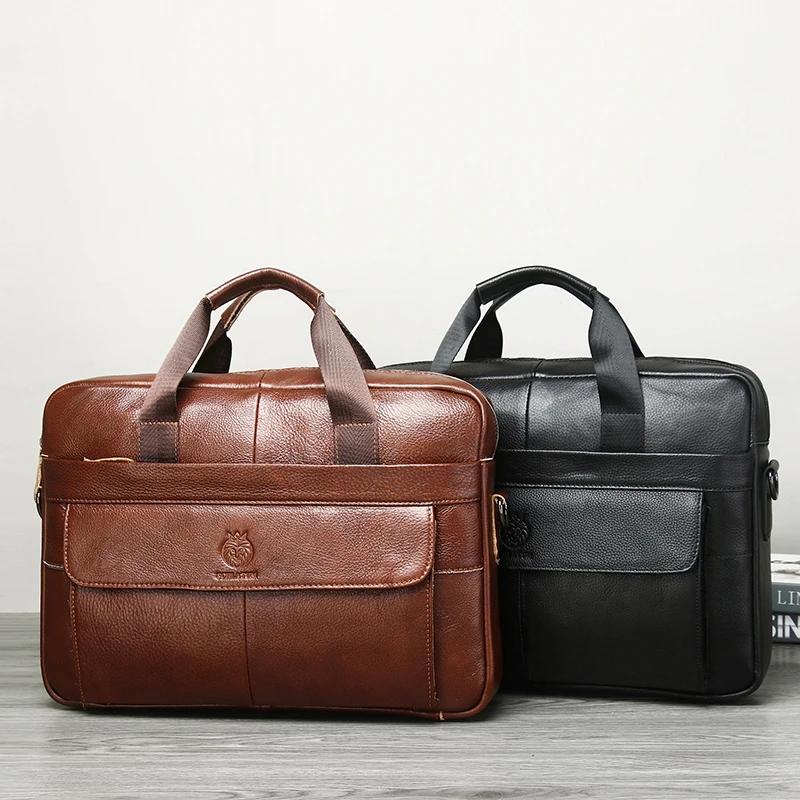
Professional Bag Scenarios: Matching Profiles to Specific Needs
The Corporate Executive
Sarah leads a team at a financial services firm, attending multiple meetings daily within the same building. Her slim attaché case perfectly complements her tailored suits while accommodating her ultralight laptop, digital planner, and essential documents. The streamlined profile conveys precision and efficiency, aligning with her leadership role and formal environment.
The Tech Consultant
Michael travels between client locations, carrying various devices, adapters, and occasionally presentation materials. His large professional backpack distributes weight evenly during his commute while providing separate compartments for his laptop, tablet, portable monitor, and technical documentation. The ample capacity ensures he’s prepared for any technical scenario without sacrificing mobility.
The Creative Director
Emma balances creative work with client presentations, requiring both artistic materials and professional documents. Her large messenger bag accommodates her laptop, digital tablet, portfolio samples, and personal items while projecting creative professionalism. The adjustable capacity adapts to varying daily requirements in her dynamic role.
The Hybrid Remote Professional
Daniel splits time between home, coffee shops, and occasional office days. His slim briefcase carries just his essential tech and minimal paperwork, complementing his mobile lifestyle. The lightweight design supports his frequent location changes while maintaining a professional appearance for in-person meetings.
For tech-focused professionals who need specialized solutions, options for tech professionals offer designs that specifically address electronic device protection and organization.
Men's Classic Leather Briefcase, Slim Leather Laptop Briefcase, Slim Leather Portfolio Briefcase
$93.67 Select options This product has multiple variants. The options may be chosen on the product pageBrown Leather Work Tote, Large Leather Work Tote
$194.38 Select options This product has multiple variants. The options may be chosen on the product pageClassic Laptop Briefcase, Men's Classic Leather Briefcase, Slim Leather Attache Case
Price range: $353.50 through $360.81 Select options This product has multiple variants. The options may be chosen on the product pageCrazy Horse Leather Satchel, Men's Leather Satchel, Men's Professional Leather Messenger, Vintage Style Messenger Bag
$132.70 Select options This product has multiple variants. The options may be chosen on the product pageBlack Leather Briefcase, Classic Laptop Briefcase, Men's Classic Leather Briefcase, Slim Leather Laptop Briefcase
$228.72 Select options This product has multiple variants. The options may be chosen on the product pageBrown Leather Messenger Bag, Men's Leather Satchel, Men's Professional Leather Messenger
$118.87 Select options This product has multiple variants. The options may be chosen on the product page
Frequency Asked Questions: Addressing Common Concerns
Q: Does a slim bag necessarily provide less laptop protection than a larger bag?
A: Not necessarily. Quality of padding and suspension systems matters more than overall bag size. Some slim bags feature excellent protection through specialized compartments, while some larger bags may offer inadequate padding despite their size.
Q: Are backpack-style business bags considered professional in conservative environments?
A: Premium leather or high-end technical fabric backpacks designed specifically for business use have gained acceptance in most professional environments. However, extremely traditional settings like courtrooms or certain financial institutions may still prefer classic briefcase styles.
Q: How can I transition from a large bag to a slim one without sacrificing functionality?
A: Begin by conducting a usage audit—track which items you actually use daily versus those that remain untouched. Digitize documents where possible, consolidate electronic devices, and consider leaving rarely-used “just in case” items at your desk rather than carrying them daily.
Q: Which bag type better protects electronics from weather?
A: Weather protection depends more on material and construction than size. Some slim bags offer excellent weather protection through waterproof zippers and treated materials, while some large bags may lack these features. Look for specific weather-resistant properties rather than assuming based on size.
For ongoing maintenance to ensure longevity, maintenance tips for professional bags provide essential guidance regardless of which size you select.
Finding the Balance: When Hybrid Options Make Sense
For professionals whose needs fluctuate regularly, hybrid bag designs offer compelling middle-ground solutions. Expandable briefcases provide a slim profile for daily use with the ability to increase capacity by 30-50% when needed. These designs feature expansion zippers or accordion panels that deploy only when additional space is required.
Convertible designs represent another innovative approach, allowing transformation between different carrying styles. Briefcases with concealed backpack straps offer formal presentation in meetings with ergonomic carrying during commutes. Messenger-tote hybrids transition between casual and formal contexts through clever strap systems.
These versatile options particularly benefit:
* Professionals who occasionally transport presentation materials
* Individuals who travel for business with varying equipment needs
* Those splitting time between different office locations with different requirements
* Workers who combine professional and personal errands during their day
While hybrid designs offer versatility, they sometimes compromise on specialized excellence. The expansion mechanisms may add weight, and convertible features might reduce durability at stress points. For most professionals, however, the comprehensive guide to professional bag options reveals that finding the right balance between capacity and profile represents the most sustainable long-term solution.
At Poise Porter, we understand that the perfect professional companion balances your practical needs with your professional image. Whether you choose slim elegance or versatile capacity, selecting a quality bag represents an investment in both your daily efficiency and professional presentation.

